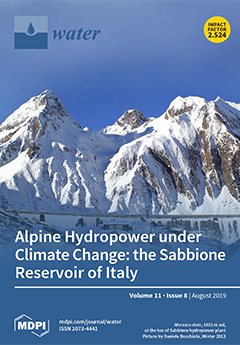Setting precise sediment load boundary conditions plays a central role in robust modeling of sedimentation in reservoirs. In the presented study, we modeled sediment transport in Tarbela Reservoir using sediment rating curves (SRC) and wavelet artificial neural networks (WA-ANNs) for setting sediment load
[...] Read more.
Setting precise sediment load boundary conditions plays a central role in robust modeling of sedimentation in reservoirs. In the presented study, we modeled sediment transport in Tarbela Reservoir using sediment rating curves (SRC) and wavelet artificial neural networks (WA-ANNs) for setting sediment load boundary conditions in the HEC-RAS 1D numerical model. The reconstruction performance of SRC for finding the missing sediment sampling data was at R
2 = 0.655 and NSE = 0.635. The same performance using WA-ANNs was at R
2 = 0.771 and NSE = 0.771. As the WA-ANNs have better ability to model non-linear sediment transport behavior in the Upper Indus River, the reconstructed missing suspended sediment load data were more accurate. Therefore, using more accurately-reconstructed sediment load boundary conditions in HEC-RAS, the model was better morphodynamically calibrated with R
2 = 0.980 and NSE = 0.979. Using SRC-based sediment load boundary conditions, the HEC-RAS model was calibrated with R
2 = 0.959 and NSE = 0.943. Both models validated the delta movement in the Tarbela Reservoir with R
2 = 0.968, NSE = 0.959 and R
2 = 0.950, NSE = 0.893 using WA-ANN and SRC estimates, respectively. Unlike SRC, WA-ANN-based boundary conditions provided stable simulations in HEC-RAS. In addition, WA-ANN-predicted sediment load also suggested a decrease in supply of sediment significantly to the Tarbela Reservoir in the future due to intra-annual shifting of flows from summer to pre- and post-winter. Therefore, our future predictions also suggested the stability of the sediment delta. As the WA-ANN-based sediment load boundary conditions precisely represented the physics of sediment transport, the modeling concept could very likely be used to study bed level changes in reservoirs/rivers elsewhere in the world.
Full article





